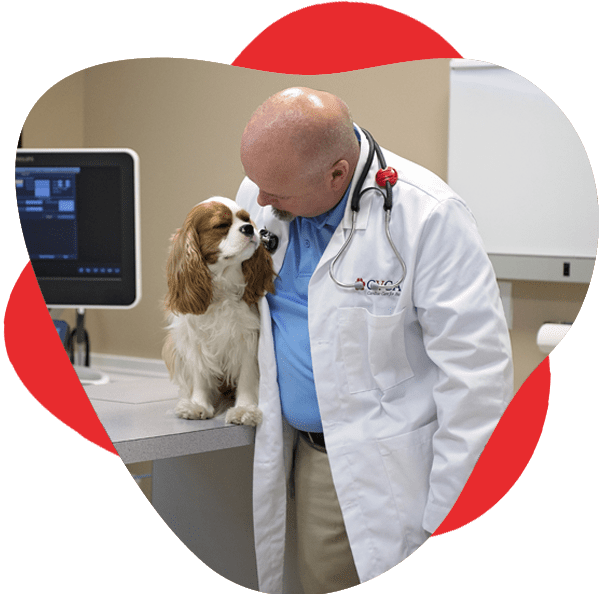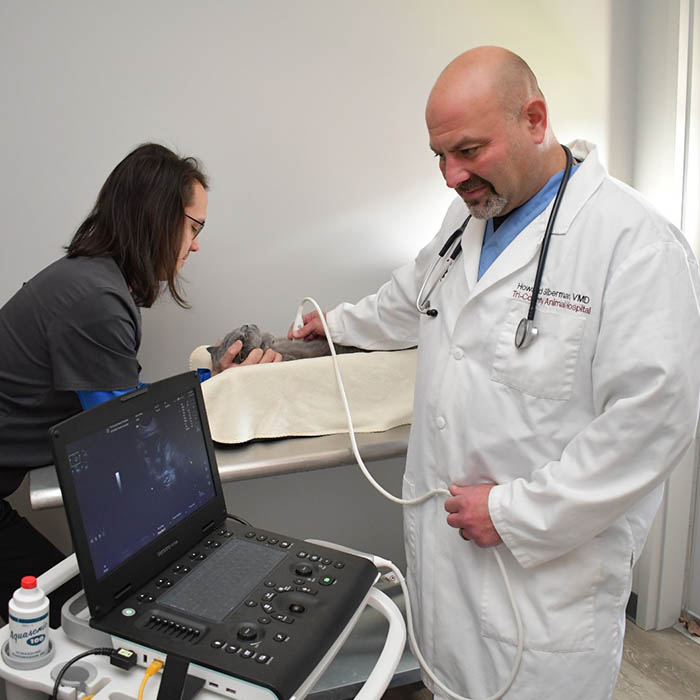The Role of Ultrasound and CT Scan in Modern Veterinary Practices: Insights From Experienced Professionals
In modern-day vet methods, ultrasound and CT scans substantially improve diagnostic capacities. These imaging methods supply critical understandings right into animal health, leading treatment choices. Experienced professionals recognize the unique benefits of each method. Ultrasound uses real-time analyses, while CT checks provide intricate physiological information. Understanding their duties and applications elevates important inquiries regarding their effect on individual results and the future of veterinary diagnostics. What understandings can be gained from their incorporated usage?
Understanding Ultrasound in Veterinary Medication
Ultrasound is a crucial analysis tool in veterinary medication, offering a non-invasive technique to imagine interior structures. This imaging strategy utilizes high-frequency audio waves to produce real-time pictures of cells and organs, allowing veterinarians to assess conditions without medical treatment. Common applications consist of evaluating the heart, liver, kidneys, and reproductive body organs, in addition to keeping track of pregnancies.The treatment is fairly quick and can be carried out in various setups, making it an accessible alternative for vets. Unlike radiography, ultrasound supplies comprehensive details regarding soft cells and blood flow, which is essential for precise diagnoses.Veterinary specialists depend on ultrasound to discover abnormalities such as tumors, cysts, and liquid accumulation. Its capacity to assist biopsies and other procedures additionally enhances its energy in professional method. By offering a effective and secure method to analyze internal makeup, ultrasound has ended up being a keystone of contemporary vet diagnostics.
The Advantages of CT Checks for Animal Diagnostics
CT checks offer substantial advantages in veterinary diagnostics by supplying enhanced accuracy in recognizing internal conditions (CT Scans For Animals). As a non-invasive imaging method, they ensure the safety and comfort of pets throughout assessments. In addition, CT scans assist in a thorough evaluation of inner structures, enabling a lot more efficient treatment preparation
Enhanced Diagnostic Accuracy
Improvements in imaging modern technology have considerably boosted analysis accuracy in veterinary medicine, especially with making use of CT scans. These scans provide comprehensive cross-sectional pictures of an animal's internal structures, allowing veterinarians to determine abnormalities with precision. The high resolution and three-dimensional abilities of CT imaging facilitate the discovery of problems such as lumps, cracks, and internal bleeding that may be missed with typical imaging approaches. In addition, CT scans can assist in pre-surgical planning by using a detailed sight of physiological partnerships. This degree of detail not only improves the accuracy of medical diagnoses yet likewise help in customizing efficient treatment strategies. The assimilation of CT modern technology right into vet methods is transforming the landscape of pet healthcare, boosting results for clients.
Non-Invasive Imaging Strategy
The introduction of non-invasive imaging methods has actually changed pet diagnostics, with CT checks arising as a popular device in veterinary practices. These scans give high-resolution, cross-sectional pictures of an animal's internal structures, enabling veterinarians to analyze complex problems without the requirement for intrusive procedures. The advantages of CT scans include their capability to spot tumors, cracks, and inner blood loss with remarkable precision. In addition, they assist in the assessment of soft cells and body organs, improving analysis capabilities. The rate of CT scanning makes it possible for quick decision-making, which is essential in emergency situations. By minimizing anxiety and discomfort for the animal, CT scans contribute to an extra humane technique to diagnostics, ultimately enhancing therapy results and advancing vet care.
Comprehensive Internal Assessment
An extensive internal analysis is important for precise diagnosis and efficient therapy in veterinary medication. CT scans deal substantial benefits hereof, giving comprehensive cross-sectional photos of a pet's internal structures. This sophisticated imaging method boosts visualization of complicated physiological areas, enabling veterinarians to identify abnormalities such as tumors, fractures, and internal bleeding with greater precision. On top of that, CT scans promote the assessment of conditions that might be testing to detect with conventional approaches. The rate and accuracy of CT imaging also add to prompt interventions, boosting patient outcomes. As vet practices increasingly incorporate CT modern technology, the benefits of considerable inner analyses end up being obvious, strengthening the value of this tool in modern vet diagnostics.
Contrasting Ultrasound and CT Imaging Techniques
While both ultrasound and CT imaging offer crucial duties in vet diagnostics, each method provides distinct advantages and restrictions that can influence clinical decision-making. Ultrasound is specifically valued for its real-time imaging abilities, enabling veterinarians to observe vibrant physiological procedures. This strategy is non-invasive, portable, and does not involve ionizing radiation, making it a safer alternative for both clinicians and animals. Ultrasound may have limitations in visualizing specific anatomical structures or deep tissues.Conversely, CT imaging offers thorough cross-sectional views of the body, permitting for precise localization of problems. It masters assessing facility body organs and structures, particularly in the thorax and abdomen. CT scans need sedation or anesthesia in numerous situations and include exposure to ionizing radiation. Ultimately, the option between ultrasound and CT depends on the certain clinical situation, the location of passion, and the seriousness of the analysis needs.
Situation Studies: Successful Medical Diagnoses Through Imaging
Study show the substantial improvements in diagnostic precision attained through sophisticated imaging technologies like ultrasound and CT scans in vet practices. These developments not only enhance the detection of numerous problems yet likewise assist in efficient and prompt treatment plans. Assessing specific situations can highlight the transformative impact of these imaging techniques on veterinary medication.
Diagnostic Precision Improvements

Imaging Innovation Advancements
As veterinary imaging innovation remains to progress, its effect on analysis capabilities comes to be increasingly obvious. Current instance research studies highlight the effective application of innovative ultrasound and CT scan methods in recognizing complicated problems. As an example, a veterinary clinic used high-resolution CT scans to detect an unusual kind of lung cancer cells in a pet, which standard imaging had missed out on. An ultrasound evaluation revealed a stomach mass in a pet cat, motivating timely surgical intervention and a positive outcome. These innovations not only boost diagnostic precision but likewise make it possible for veterinarians to create targeted treatment strategies. By leveraging advanced imaging technologies, veterinary specialists are markedly boosting patient treatment, bring about a lot more efficient monitoring of numerous wellness problems in animals.
The Role of Imaging in Emergency Vet Care
Imaging plays an essential duty in emergency vet treatment, offering veterinarians with vital information needed to make quick, informed choices. In immediate scenarios, techniques like ultrasound and CT scans allow experts to promptly evaluate a pet dog's inner structures, identifying vital problems such as interior bleeding, cracks, or organ problems. These imaging methods permit real-time assessments, assisting in prompt treatments that can be life-saving. For example, ultrasound is invaluable for reviewing soft cells injuries and problems like liquid accumulation, while CT scans offer in-depth pictures of complicated anatomical frameworks, crucial for detecting injury instances. The speed and precision of these imaging strategies boost the veterinarian's capacity to develop efficient therapy strategies, guaranteeing the most effective feasible results for their people. The integration of advanced imaging innovations right into emergency situation vet techniques is not only useful however increasingly necessary, as it enhances diagnostic abilities and improves total pet care during crucial moments.

Training and Proficiency in Veterinary Imaging
Innovative imaging strategies such as ultrasound and CT scans are vital for efficient vet treatment, the effective application of these technologies greatly depends on the training and expertise of vet specialists. Skilled use of imaging devices requires thorough expertise of anatomy, pathology, and the principles underlying each technique. Veterinary professionals should go through specialized training to properly interpret imaging results, which is essential for detecting conditions and planning treatment.Certifications and continuing education in vet imaging enhance the skills of experts, allowing them to remain upgraded with technological developments. Partnership in between radiologists and veterinarians usually results in boosted diagnostic accuracy, as specialists can provide understandings right into complex instances. In enhancement, sensible experience in handling imaging devices cultivates self-confidence in its application. Ultimately, the high quality of vet imaging services is directly associated to the degree of training and know-how had by the professionals utilizing these important analysis devices.
Future Trends in Diagnostic Imaging for Animals
With the fast improvements in modern technology, veterinary analysis imaging CT Scans For Dogs is positioned for substantial advancement in the coming years. Emerging patterns suggest a shift towards even more obtainable and mobile imaging modalities, such as portable ultrasound devices, which could boost field diagnostics. Additionally, the assimilation of expert system is expected to change photo analysis, allowing for quicker and much more exact analyses of results.Moreover, developments in 3D imaging techniques and computed tomography will give vets with even more thorough views of pet composition, resulting in enhanced treatment strategies. Online fact innovation may likewise play a role in medical preparation and education and learning, giving vets an unique perspective on complicated cases.As telemedicine remains to expand, remote appointments facilitated by analysis imaging will come to be much more common, allowing specialists to assist family doctors in real-time. In general, these patterns are readied to improve the performance and effectiveness of vet treatment, eventually improving pet end results.
Often Asked Inquiries
Exactly How Much Do Ultrasound and CT Checks Expense in Vet Centers?
The prices of ultrasound and CT scans in veterinary clinics normally vary from $300 to $1,500, relying on aspects such as location, center type, and certain procedures needed for the pet's diagnosis and treatment.

Exist Any Kind Of Dangers Related To Ultrasound and CT Scans for Animals?
Ultrasound and CT scans generally position minimal risks to pet dogs. Potential problems consist of sedation responses and direct exposure to anesthetics. Veterinarians thoroughly assess each situation to minimize any risks related to these analysis procedures
Just How Long Do Ultrasound and CT Treatments Normally Take?
Ultrasound procedures normally take around 30 minutes to an hour, relying on the complexity. CT scans, being even more detailed, generally call for 30 minutes to 90 minutes, consisting of prep work and recovery time for the animal.
Can All Veterinarians Perform Ultrasounds and CT Scans?
Not all vets can perform ultrasounds and CT scans. Specialized training and qualification are typically needed to assure expertise in these advanced imaging strategies, which might limit their availability to vets with added certifications and resources.
What Types of Animals Benefit Many From These Imaging Techniques?
Specific animal species, specifically pets and felines, benefit substantially from ultrasound and CT scans. These imaging techniques enhance diagnostic accuracy for problems like lumps, internal injuries, and body organ problems, bring about better treatment results and individual treatment. The high resolution and three-dimensional capabilities of CT imaging facilitate the discovery of problems such as lumps, cracks, and interior blood loss that could be missed out on with traditional imaging methods. Case studies illustrate the substantial renovations in analysis accuracy achieved via innovative imaging innovations like ultrasound and CT scans in vet methods. Improving analysis precision in vet practices has been substantially helped by improvements in imaging innovations such as ultrasound and CT scans. Sophisticated imaging strategies such as ultrasound and CT scans are vital for effective veterinary treatment, the effective implementation of these modern technologies greatly depends on the training and know-how of veterinary specialists. Veterinary professionals must undertake specific training to precisely translate imaging outcomes, which is crucial for diagnosing problems and preparing treatment.Certifications and proceeding education and learning in veterinary imaging boost the skills of specialists, allowing them to stay upgraded with technological developments.